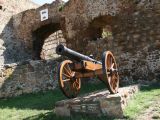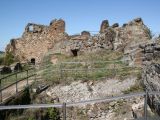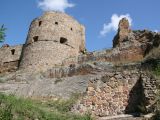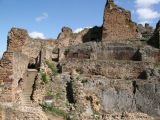National Cultural Monuments
The Filakovo Castle
In the 12th century there was already the castle with a square tower, palace and palisade on the volcanic top of a basalt rock 65m high. In 1551 it was enlarged and stronged. The middle and lower castle was built with two pentagonal bastions, walls, entrance corridor and cannon positions. In the same time the town got the wall with the gates and bastions as well.
The origin of the castle is connected with the tale about a shepherd called Filek, and his dog Fules, as they found treasure, from which a castle was built.
The old records says, that a robber knight called Fulko was the owner of the castle as long as king Belo IV confiscated it in 1246. Then Matus Csák (1311-1321), queen Elizabeth (1438) and Francis Bebek were the owners of the castle.
The castle was a component of the defence line against the Turkish expansion in the 16-th century. In 1554 the Turks captured the castle and had been governing in and around Filakovo for 39 years. Counts Nicholas Pállfy and Christooph Tiefenbach liberated the castle and its surroundings in 1593. There was a fire, which ruined a part of the castle and town in 1615. Stephanus Koháry I got the castle from the emperor in 1657. His son, Stephanus Koháry II ordered to rebuild the ruined parts in 1667.
Emerich Thököly, the reigning prince of Transsylvania with the help of the big Turkish army captured the castle in 1682. The castle was destroyed and since this year remained in ruins. Thököly was proclaimed the Hungarian king here.
Stephanus Koháry II after his liberation from Thököly's confinement ordered to build the new church and monastery in 1725. The last owners of the castle were the Coburgs.
The Church Devoted to Holy Mary´s Assumption and the Franciscan Monastery
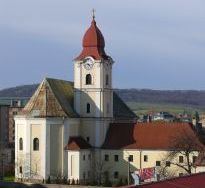 The Roman-Catholic Church
The Roman-Catholic Church
The original church with the Franciscian Monastery from 1513 was changed to Turkish temple in 1554 - 1593. In 1682 it was destroyed. The church was rebuilt in 1694 - 1727 by István Koháry II. Its present form is from 1728. The baroque interior of the church is richly decorated. The tower is situated uncharacteristically on its north-eastern side.
The Franciscian Monastery
The monastery is connected with the north-western side of the church. The building has two floors. Franciscan friars had significantly influenced the spiritual life of the town.

